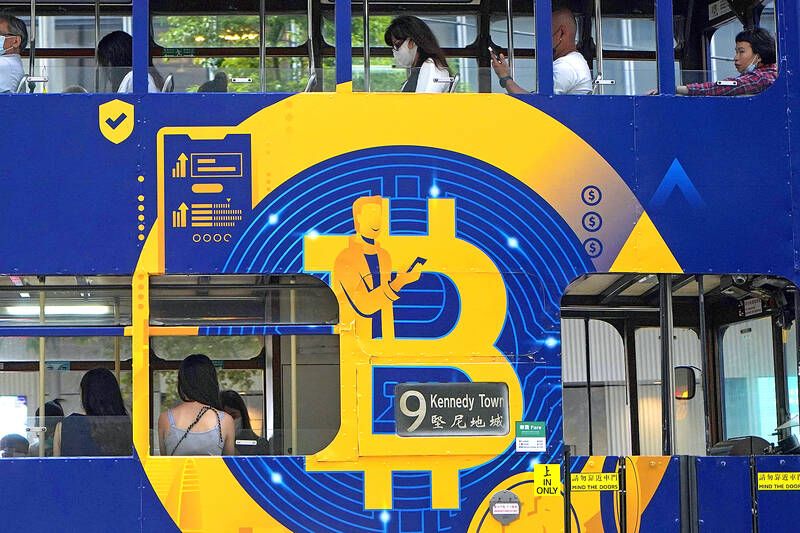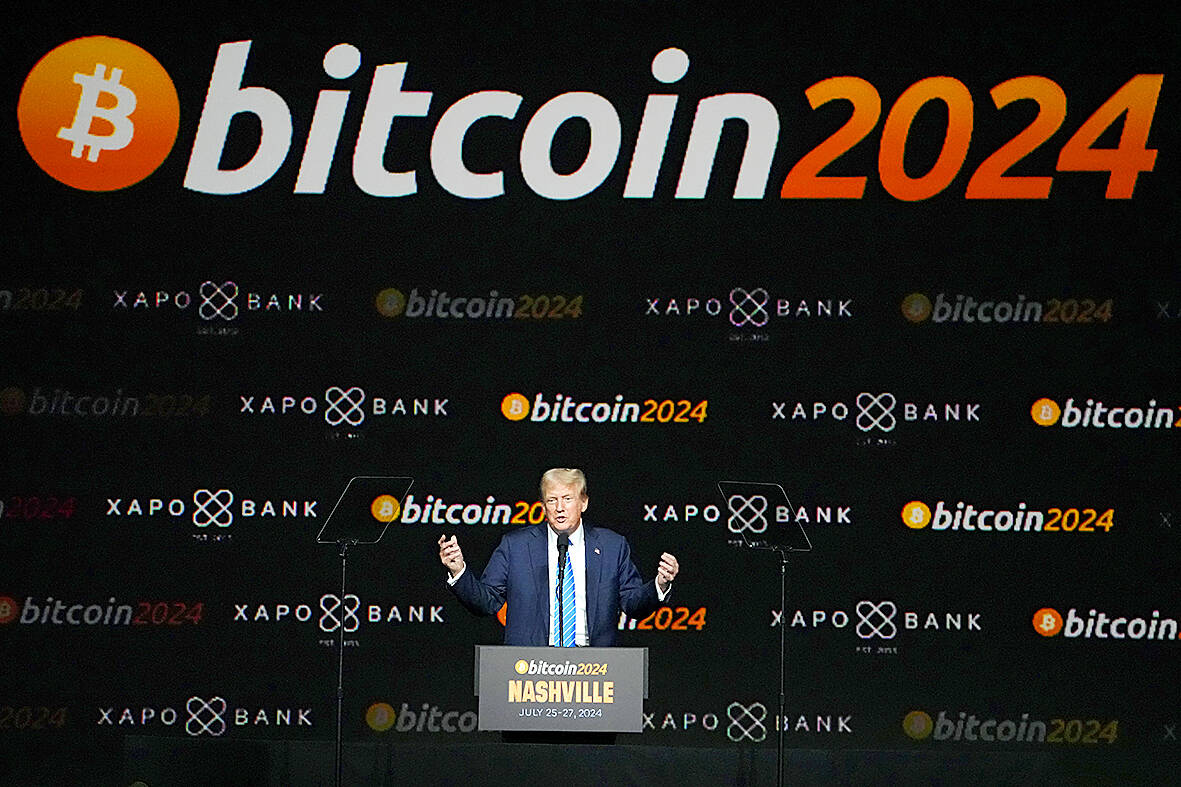Bitcoin topped US$100,000 for the first time this week as a massive rally in the world’s most popular cryptocurrency, largely accelerated by the election of Donald Trump, rolls on.
The cryptocurrency officially rose six figures Wednesday night, just hours after the president-elect said he intends to nominate cryptocurrency advocate Paul Atkins to be the next chair of the Securities and Exchange Commission.
Bitcoin has soared since Trump won the US presidential election on Nov. 5. The asset climbed from US$69,374 on Election Day, hitting as high as US$103,713 Wednesday, according to CoinDesk. And the latest all-time high arrives just two years after bitcoin dropped below US$17,000 following the collapse of crypto exchange FTX.

Photo: AP
Bitcoin fell back below the US$100,000 by Thursday afternoon, sitting above US$99,000 by 4 pm ET. Even amid a massive rally that has more than doubled the value of bitcoin this year, some experts continue to warn of investment risks around the asset, which has quite a volatile history.
Here’s what you need to know.
WHAT IS CRYPTOCURRENCY

Photo: AP
Cryptocurrency has been around for a while now. But chances are you’ve heard about it more and more over the last few years.
In basic terms, cryptocurrency is digital money. This kind of currency is designed to work through an online network without a central authority — meaning it’s typically not backed by any government or banking institution — and transactions get recorded with technology called a blockchain.
Bitcoin is the largest and oldest cryptocurrency, although other assets like ethereum, XRP, tether and dogecoin have also gained popularity over the years. Some investors see cryptocurrency as a “digital alternative” to traditional money, but most daily financial transactions are still conducted using fiat currencies such as the dollar. Also, bitcoin can be very volatile, with its price reliant on larger market conditions.

Photo: AP
WHY IS BITCOIN SOARING
A lot of the recent action has to do with the outcome of the US presidential election.
Trump, who was once a crypto skeptic, has pledged to make the US “the crypto capital of the planet” and create a “strategic reserve” of bitcoin. His campaign accepted donations in cryptocurrency and he courted fans at a bitcoin conference in July. He also launched World Liberty Financial, a new venture with family members to trade cryptocurrencies.
On Thursday morning, hours after bitcoin surpassed the US$100,000 mark, Trump congratulated “BITCOINERS” on his social media platform Truth Social. He also appeared to take credit for the recent rally, writing, “YOU’RE WELCOME!!!”
Top crypto players welcomed Trump’s election victory last month, in hopes that he would be able to push through legislative and regulatory changes that they’ve long lobbied for — which, generally speaking, aim for an increased sense of legitimacy without too much red tape. And the industry has made sizeable investments along the way. Back in August, Public Citizen, a left-leaning consumer rights advocacy nonprofit, reported finding that crypto-sector corporations spent more than US$119 million this year to back pro-crypto candidates across federal elections.
Trump made his latest pro-crypto move when he announced his plans Wednesday to nominate Atkins to chair the SEC. Atkins was an SEC commissioner during the presidency of George W. Bush. In the years since leaving the agency, Atkins has made the case against too much market regulation. He joined the Token Alliance, a cryptocurrency advocacy organization, in 2017.
Under current chair Gary Gensler, who will step down when Trump takes office, the SEC has cracked down on the crypto industry — penalizing a number of companies for violating securities laws. Gensler has also faced ample criticism from industry players in the process.
One crypto-friendly move the SEC did make under Gensler was the approval in January of spot bitcoin ETFs, or exchange trade funds, which allow investors to have a stake in bitcoin without directly buying it. The spot ETFs were the dominant driver of bitcoin’s price before Trump’s win — but, like much of the crypto’s recent momentum, saw record inflows postelection.
US$100K — COULD IT KEEP CLIMBING?
Bitcoin surpassing the coveted US$100,000 mark has left much of the crypto world buzzing.
“What we’re seeing isn’t just a rally — it’s a fundamental transformation of bitcoin’s place in the financial system,” Nathan McCauley, CEO and co-founder of crypto custodian Anchorage Digital, said in a statement — while pointing to the growth of who’s entering the market, particularly with rising institutional adoption.
Still, others note that the new heights of bitcoin’s price don’t necessarily mean the asset is going mainstream. The US$100,000 level is “merely a psychological factor and ultimately just a number,” Dan Coatsworth, investment analyst at British investment company AJ Bell, wrote in a Thursday commentary.
That being said, bitcoin could keep climbing to more and more all-time highs, particularly if Trump makes good on his promises for more crypto-friendly regulation once in office. If Trump actually makes a bitcoin reserve, for example, supply changes could also propel the price forward.
“It is hard to overstate the magnitude of the change in Washington’s attitude towards crypto post-election,” Matt Hougan, chief investment officer at Bitwise Asset Management, said via e-mail Thursday, reiterating that prices could keep rising if trends persist. “There is a lot more demand than there is supply, and that’s usually a pretty good recipe for success.”
Still, as with everything in the volatile cryptoverse, the future is never promised. Worldwide regulatory uncertainties and environmental concerns around bitcoin “mining” — the creation of new bitcoin, which consumes a lot of energy — are among factors that analysts like Coatsworth note could hamper future growth. And, as still a relatively young asset with a history of volatility, longer-term adoption has yet to be seen through.
IS IT TOO LATE TO INVEST?
Today’s excitement around bitcoin may make many who aren’t already in the space want to get in on the action. For those in a position to invest, Hougan says it’s not too late — noting that bitcoin is still early in its development and most institutional investors “still have zero exposure.”
At the same time, Hougan and others maintain that it’s important to tread cautiously and not bite off more than you can chew. Experts continue to stress caution around getting carried away with crypto “FOMO,” or the fear of missing out, especially for small-pocketed investors.
“A lot of people have got rich from the cryptocurrency soaring in value this year, but this high-risk asset isn’t suitable for everyone,” Coatsworth noted Thursday. “It’s volatile, unpredictable and is driven by speculation, none of which makes for a sleep-at-night investment.”
In short, history shows you can lose money in crypto as quickly as you’ve made it. Long-term price behavior relies on larger market conditions. Trading continues at all hours, every day.
Coatsworth points to recent research from the Bank for International Settlements, a Switzerland-based global organization of central banks, which found that about three-quarters of retail buyers on crypto exchange apps likely lost money on their bitcoin investments between 2015 and 2022.
At the start of the COVID-19 pandemic, bitcoin stood at just over US$5,000. Its price climbed to nearly US$69,000 by November 2021, during high demand for technology assets, but later crashed during an aggressive series of rate hikes by the Federal Reserve. And the late-2022 collapse of FTX significantly undermined confidence in crypto overall, with bitcoin falling below US$17,000.
Investors began returning in large numbers as inflation started to cool — and gains skyrocketed on the anticipation and then early success of spot ETFs, and again, now the post-election frenzy. But lighter regulation from the coming Trump administration could also mean less guardrails.

The canonical shot of an East Asian city is a night skyline studded with towering apartment and office buildings, bright with neon and plastic signage, a landscape of energy and modernity. Another classic image is the same city seen from above, in which identical apartment towers march across the city, spilling out over nearby geography, like stylized soldiers colonizing new territory in a board game. Densely populated dynamic conurbations of money, technological innovation and convenience, it is hard to see the cities of East Asia as what they truly are: necropolises. Why is this? The East Asian development model, with

June 16 to June 22 The following flyer appeared on the streets of Hsinchu on June 12, 1895: “Taipei has already fallen to the Japanese barbarians, who have brought great misery to our land and people. We heard that the Japanese occupiers will tax our gardens, our houses, our bodies, and even our chickens, dogs, cows and pigs. They wear their hair wild, carve their teeth, tattoo their foreheads, wear strange clothes and speak a strange language. How can we be ruled by such people?” Posted by civilian militia leader Wu Tang-hsing (吳湯興), it was a call to arms to retake

This is a deeply unsettling period in Taiwan. Uncertainties are everywhere while everyone waits for a small army of other shoes to drop on nearly every front. During challenging times, interesting political changes can happen, yet all three major political parties are beset with scandals, strife and self-inflicted wounds. As the ruling party, the Democratic Progressive Party (DPP) is held accountable for not only the challenges to the party, but also the nation. Taiwan is geopolitically and economically under threat. Domestically, the administration is under siege by the opposition-controlled legislature and growing discontent with what opponents characterize as arrogant, autocratic

When Lisa, 20, laces into her ultra-high heels for her shift at a strip club in Ukraine’s Kharkiv, she knows that aside from dancing, she will have to comfort traumatized soldiers. Since Russia’s 2022 invasion, exhausted troops are the main clientele of the Flash Dancers club in the center of the northeastern city, just 20 kilometers from Russian forces. For some customers, it provides an “escape” from the war, said Valerya Zavatska — a 25-year-old law graduate who runs the club with her mother, an ex-dancer. But many are not there just for the show. They “want to talk about what hurts,” she